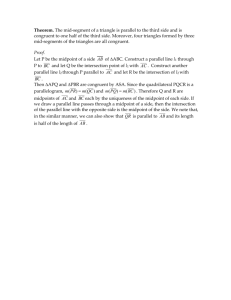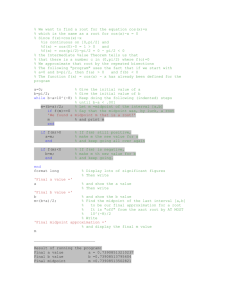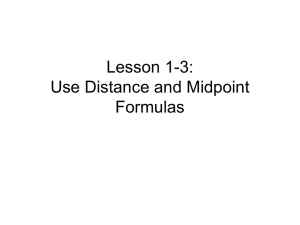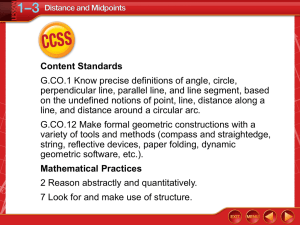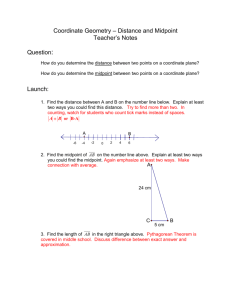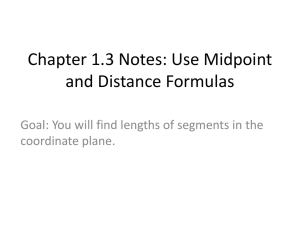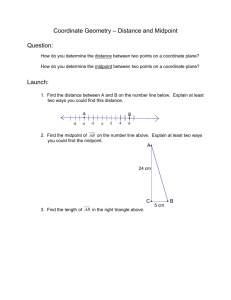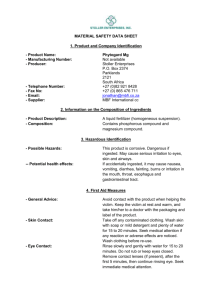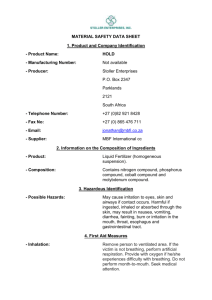User_Guide_OpenIO_3... - The Sustainability Consortium
advertisement
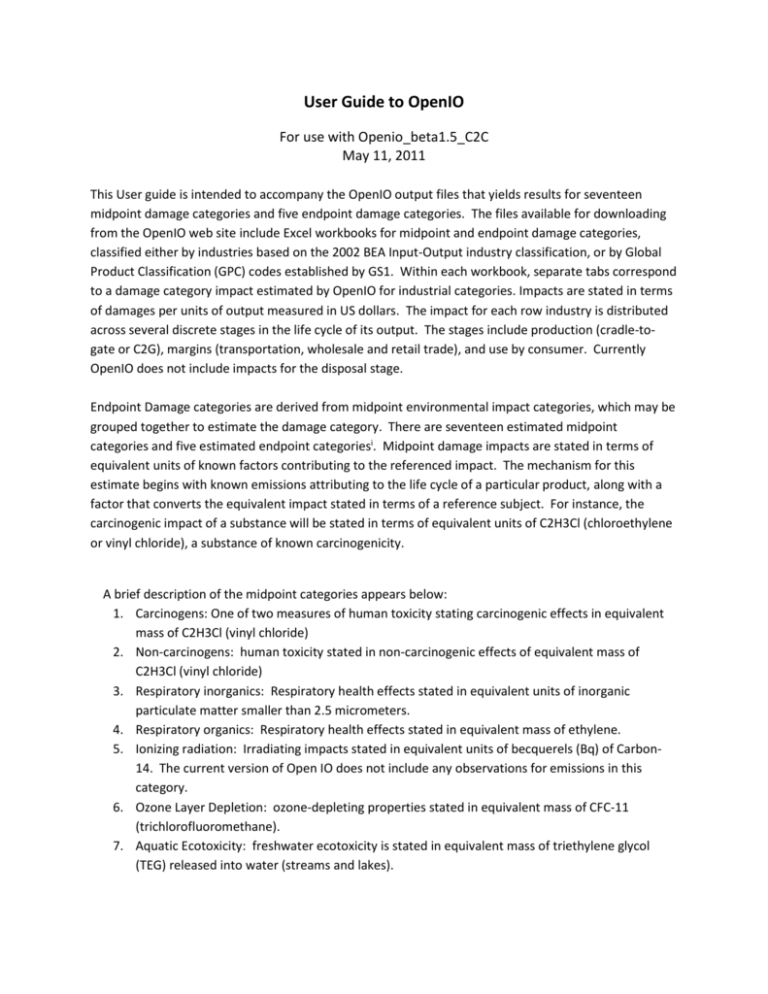
User Guide to OpenIO For use with Openio_beta1.5_C2C May 11, 2011 This User guide is intended to accompany the OpenIO output files that yields results for seventeen midpoint damage categories and five endpoint damage categories. The files available for downloading from the OpenIO web site include Excel workbooks for midpoint and endpoint damage categories, classified either by industries based on the 2002 BEA Input-Output industry classification, or by Global Product Classification (GPC) codes established by GS1. Within each workbook, separate tabs correspond to a damage category impact estimated by OpenIO for industrial categories. Impacts are stated in terms of damages per units of output measured in US dollars. The impact for each row industry is distributed across several discrete stages in the life cycle of its output. The stages include production (cradle-togate or C2G), margins (transportation, wholesale and retail trade), and use by consumer. Currently OpenIO does not include impacts for the disposal stage. Endpoint Damage categories are derived from midpoint environmental impact categories, which may be grouped together to estimate the damage category. There are seventeen estimated midpoint categories and five estimated endpoint categoriesi. Midpoint damage impacts are stated in terms of equivalent units of known factors contributing to the referenced impact. The mechanism for this estimate begins with known emissions attributing to the life cycle of a particular product, along with a factor that converts the equivalent impact stated in terms of a reference subject. For instance, the carcinogenic impact of a substance will be stated in terms of equivalent units of C2H3Cl (chloroethylene or vinyl chloride), a substance of known carcinogenicity. A brief description of the midpoint categories appears below: 1. Carcinogens: One of two measures of human toxicity stating carcinogenic effects in equivalent mass of C2H3Cl (vinyl chloride) 2. Non-carcinogens: human toxicity stated in non-carcinogenic effects of equivalent mass of C2H3Cl (vinyl chloride) 3. Respiratory inorganics: Respiratory health effects stated in equivalent units of inorganic particulate matter smaller than 2.5 micrometers. 4. Respiratory organics: Respiratory health effects stated in equivalent mass of ethylene. 5. Ionizing radiation: Irradiating impacts stated in equivalent units of becquerels (Bq) of Carbon14. The current version of Open IO does not include any observations for emissions in this category. 6. Ozone Layer Depletion: ozone-depleting properties stated in equivalent mass of CFC-11 (trichlorofluoromethane). 7. Aquatic Ecotoxicity: freshwater ecotoxicity is stated in equivalent mass of triethylene glycol (TEG) released into water (streams and lakes). 8. Terrestrial Ecotoxicity: Land-based ecotoxicity stated in equivalent mass of triethylene glycol released into the soil. 9. Terrestrial acidification/nitrification: land-based acidification and nitrification are stated in equivalent mass of sulfur dioxide (SO2) released into the air. 10. Land Occupation: Units for land occupation are stated in square meters of arable land. 11. Aquatic Acidification: Units are the same as for land-based acidification. However, no endpoint damage factors are assigned to this in Impact 2002+. 12. Aquatic Eutrophication: Aquatic eutrophication is stated in equivalent mass of phosphate (PO43). However, no endpoint damage factors are assigned to this in Impact 2002+. 13. Global Warming: Impacts for global warming are stated in equivalent mass of carbon dioxide (CO2) released into the air. 14. Non-renewable Energy: Impacts are stated in megajoules (MJ) of energy per dollar of output of primary energy sectors (coal, oil, and natural gas). 15. Mineral Extraction: Mineral extraction impacts are stated in megajoules of surplus energy per kilogram of extracted substance. The current version of Open IO does not include any observations for impacts of mineral extraction. 16. Water Withdrawal: Not a feature in Impact 2002+, units are stated in terms of gallons. 17. Water Consumption: Not a feature in Impact 2002+, units are stated in terms of gallons. Midpoint damage categories can be grouped into five endpoint damage categories. Each damage category is described in detail below: 1. Climate change. The factors from the global warming midpoint category are carried into the climate change endpoint damage category. This is measured in terms of kilograms of carbon dioxide (CO2) equivalent emitted per US dollar of output for the row industry. CO2 is the principal “greenhouse gas” present in the earth’s atmosphere, and the increase in greenhouse gases has been linked to an increase in global temperatures. Other major greenhouse gases include methane, water vapor, nitrous oxide, and ozone. The contribution to the greenhouse effect by a gas is affected by both the characteristics of the gas and its abundance. For purposes of creating a common metric, the potential for each greenhouse gas has been converted to comparable units of CO2. Human health. The midpoint categories for human toxicity (carcinogenic and non-carcinogenic), respiratory (organic and inorganic) effects, ionizing radiation, and ozone layer depletion each factor into Human health impacts. Human health is expressed in terms of Disability Adjusted Life Years (DALY). The concept is meant to measure the loss of “healthy” years of life due to premature death or disability. In this metric, mortality and morbidity are combined into a single variable. The value represents the impact in terms of DALY for each US dollar of output for the row industry. Ecosystem quality. This includes midpoint categories for aquatic and terrestrial ecotoxicity, terrestrial acidification/nitrification, and land occupation. A measure of biodiversity, this is expressed in terms of Potentially Disappeared Fraction of species per square meter per year (PDF*m2*yr). This represents the percentage of species disappearing from one square meter of earth surface during one year per US dollar of output. Values in excess of 1 should be scaled to an appropriate surface area. For instance, a PDF*m2*yr of 5.1 means that 51 percent of species in a 10 m2 area would become extinct, or 5.1 percent in 100 m2. Resources. This is composed of the midpoint category for nonrenewable energy use . It used to measure the energy requirement to produce the output of each row industry. The unit of measurement is one megajoule of primary energy per dollar of output. Water consumption. Water consumption is in the same terms as the midpoint categories for water use and water consumption. OpenIO includes an estimate of water consumption (separated from resource use) that is expressed in terms of gallons of water used per one US dollar of output for each row industry. Each tab in the workbook shows impacts per US dollar of output for each stage of the product’s life cycle. These are: C2G (Cradle to gate). All “upstream” production, from the extraction of raw materials to the exit gate of the production facility. Transportation of finished goods. Once a product has left the production facility, impacts are shown for the transportation phase involved in getting the product to the consumer. Four transportation modes shown are Rail, Air, Water, Truck, and Pipeline. Some products may use more than one mode of transportation. Wholesale Trade and Retail Trade. Referred to as “margins” these represent the impact of the output of the wholesale and retail sectors needed to deliver the product to the final user. It does not include the cost to the wholesaler or retailer of the materials sold, but rather the impact of providing the services needed to sell the product at the wholesale or retail level. Use Phase. The use phase includes impacts from final use of the product. Once a product has been delivered to the consumer, the impacts of its use over its expected lifetime are estimated. At the present time, the only consumer use phase impacts are measured for those products that directly use energy, either by battery power, electricity from an outlet, or by burning some type of fuel. Impacts are available only for those products which the US Bureau of Economic Analysis has published estimates of personal consumption expenditures. Example Below are listed environmental impacts associated with the life cycle of dog and cat food. Table 1 Life Cycle Impacts of Pet Food Products↓ Life Cycle Stages → 311111 - Dog and cat food manufacturing C2G All transportation 420000 Wholesale trade 4A0000 - Retail trade Use Phase Total Climate change 1.050 0.043 0.069 0.160 0.000 1.321 Human Health* 0.011 001 0.001 0.001 0.000 0.013 Ecosystem Quality 9.554 0.041 0.277 0.418 0.000 10.289 Resources 11.955 0.358 0.899 1.882 0.000 15.095 Water Consumption 49.690 0.079 0.322 1.065 0.000 51.156 *For display purposes data has been presented in thousands of DALYs Recall that impacts are given per US dollar of output. Examining what the impact of expanding the production of pet food by $1 million would yield the following environmental impacts. About 1.32 million Kg of CO2 equivalent will be released into the atmosphere. In terms of human health, this level of production would result in an impact of 13.0 DALYs, and ecosystem quality would be affected by an expected extinction of about 10.3 percent of species in 100 square kilometers (using the appropriate scalars). This level of pet food production including both direct and indirect requirements would need 15.095 TJ of energy, and would consume over 51 million gallons of water. Most impacts in the life cycle of pet food occur in the production phase (C2G). Because OpenIO only measures use phase impacts for products that directly use energy, no impacts are assigned to that phase in this particular industry. For More Information This User Guide is intended to assist in the interpretation of results presented for damage category impacts only. Some users may want information on midpoint categories or other features of the model. Additional data files are available for downloading from the OpenIO website http://www.sustainabilityconsortium.org/open-io/. Complete documentation of methodologies and data sources is available on the OpenIO web site. i OpenIO adheres to impact factors developed for IMPACT 2002+, at the Swiss Federal Institute of Technology, Lausanne, Switzerland. For additional information on IMPACT 2002, please refer to Sébastien Humbert, Manuele Margni, and Olivier Jolliet, IMPACT 2002+: User Guide Draft for version 2.1, Industrial Ecology & Life Cycle Systems Group, GECOS, Swiss Federal Institute of Technology Lausanne (EPFL), CH-1015 Lausanne, Switzerland, October 2005. Available for downloading at http://www.sph.umich.edu/riskcenter/jolliet/impact2002+form.htm.

